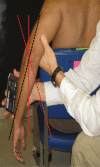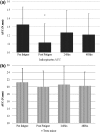A comparison of range of motion change across four posterior shoulder tightness measurements after external rotator fatigue
- PMID: 25133078
- PMCID: PMC4127512
A comparison of range of motion change across four posterior shoulder tightness measurements after external rotator fatigue
Abstract
Background: Several glenohumeral joint (GHJ) positions have been recommended for assessing and correcting posterior shoulder tightness (PST) however, there is no agreement on which position is better for differentiating posterior muscle tightness from posterior capsular tightness. The purpose of this study was to compare the range of motion change before and after an external humeral rotator muscle fatigue protocol in order to identify a position that shows maximum range of motion change.
Methods: ROM changes across four PST measurements were compared before, immediately after, at 24 hours after, and 48 hours after an external rotator fatigue protocol. Muscle stiffness of the infraspinatus and the teres minor (using a myotonometer) and external rotation force production (using hand-held dynamometry) were measured to verify muscle fatigue.
Results: There was a statistically significant interaction between measurement and condition (F = 2.47, p = 0.02). The planned one factor repeated measure ANOVA for each condition revealed that ROM change was statistically significant between PST measurements for all conditions. Post hoc comparisons indicated statistically significant greater overall ROM changes in a measurement combining GHJ extension and internal rotation compared to other tested measurements. There was also a main effect of time on infraspinatus muscle stiffness (F = 10.5, p < 0.0001). Post hoc comparison indicated a statistically significant increase in infraspinatus stiffness immediately after the fatigue protocol (p < 0.05).
Conclusion: Immediate ROM reduction was observed across all the measurements except horizontal adduction (HAD). Maximum ROM reduction after an external rotation fatigue protocol was measured in a position of GHJ extension.
Clinical relevance: Posterior muscle tightness may influence the internal rotation range of motion to a greater extent when measured in glenohumeral joint extension.
Levels of evidence: II-B.
Keywords: Glenohumeral joint; clinical measurement; horizontal adduction; internal rotation; muscle stiffness.
Figures



References
-
- Pappas AM Zawacki RM McCarthy CF Rehabilitation of the pitching shoulder. Am J Sports Med. 1985; 13: 223‐235 - PubMed
-
- Warner JJP Micheli LJ Arslanian LE et al. Patterns of flexibility, laxity, and strength in normal shoulders and shoulders with instability and impingement. Am J Sports Med. 1990; 18: 366. - PubMed
-
- Bigliani LU Codd TP Connor PM et al. Shoulder motion and laxity in the professional baseball player. Am J Sports Med. 1997; 25: 609‐613 - PubMed
-
- Crockett HC Gross LB Wilk KE et al. Osseous adaptation and range of motion at the glenohumeral joint in professional baseball pitchers. Am J Sports Med. 2002; 30: 20‐6 - PubMed
-
- Ellenbecker TS Roetert EP Bailie DS et al. Glenohumeral joint total rotation range of motion in elite tennis players and baseball pitchers. Med Sci Sports Exerc. 2002; 34: 2052‐2056 - PubMed
LinkOut - more resources
Full Text Sources
Research Materials
